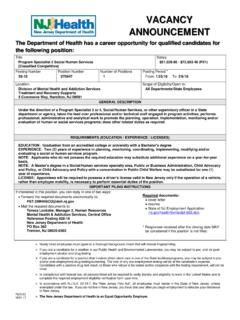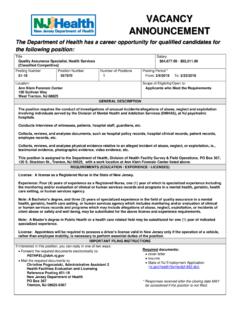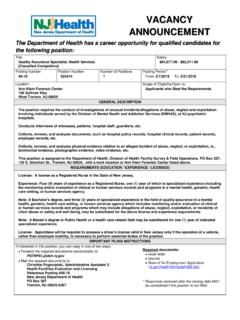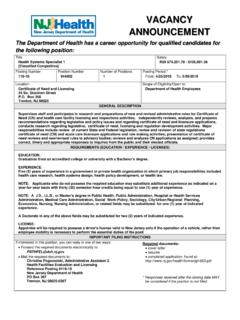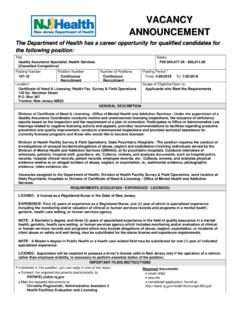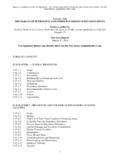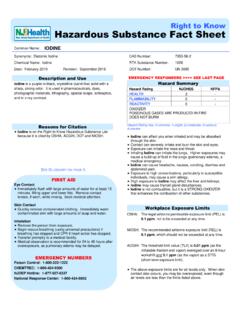Transcription of ZINC OXIDE HAZARD SUMMARY - Government of New Jersey
1 Common Name: zinc OXIDE CAS Number: 1314-13-2 DOT Number: UN 3077 DOT HAZARD Class: 9 (Miscellaneous Hazardous Material) ---------------------------------------- --------------------------------- HAZARD SUMMARY * zinc OXIDE can affect you when breathed in. * Exposure to zinc OXIDE can cause metal fume fever. This is a flu-like illness with symptoms of metallic taste in the mouth, headache, fever and chills, aches, chest tightness and cough. The symptoms may be delayed for several hours after exposure and usually last for a day or two. * zinc OXIDE may be released when welding galvanized metal. IDENTIFICATION zinc OXIDE is a white or yellowish-white, odorless powder which is used in pigments, rubber, paints, ceramics, plastics, cosmetics and pharmaceuticals.
2 zinc OXIDE fumes are fine, white, odorless particles which are formed when zinc or zinc alloys are heated to high temperatures (such as in welding, galvanizing and smelting). REASON FOR CITATION * zinc OXIDE is on the Hazardous Substance List because it is regulated by OSHA and cited by ACGIH, DOT, NIOSH, DEP and EPA. * Definitions are provided on page 5. HOW TO DETERMINE IF YOU ARE BEING EXPOSED The New Jersey Right to Know Act requires most employers to label chemicals in the workplace and requires public employers to provide their employees with information and training concerning chemical hazards and controls. The federal OSHA HAZARD Communication Standard (29 CFR ) requires private employers to provide similar training and information to their employees.
3 * Exposure to hazardous substances should be routinely evaluated. This may include collecting personal and area air samples. You can obtain copies of sampling results from your employer. You have a legal right to this information under the OSHA Access to Employee Exposure and Medical Records Standard (29 CFR ). RTK Substance number: 2037 Date: February 2000 Revision: January 2007 ---------------------------------------- --------------------------------- * If you think you are experiencing any work-related health problems, see a doctor trained to recognize occupational diseases. Take this Fact Sheet with you. WORKPLACE EXPOSURE LIMITS OSHA: The legal airborne permissible exposure limit (PEL) is 5 mg/m3 (for zinc OXIDE fume), 15 mg/m3 (for total dust ), and 5 mg/m3 (for respirable dust ) averaged over an 8-hour workshift.
4 NIOSH: The recommended airborne exposure limit is 5 mg/m3 (for zinc OXIDE fume and dust ) averaged over a 10-hour workshift, 10 mg/m3 as a short-term exposure limit (for zinc OXIDE fume), and 15 mg/m3 (for zinc OXIDE dust ), not to be exceeded at any time. ACGIH: The recommended airborne exposure limit is 2 mg/m3 averaged over an 8-hour workshift and 10 mg/m3 as a STEL (short-term exposure limit) for the respirable fraction. WAYS OF REDUCING EXPOSURE * Where possible, enclose operations and use local exhaust ventilation at the site of chemical release. If local exhaust ventilation or enclosure is not used, respirators should be worn. * Wear protective work clothing.
5 * Wash thoroughly immediately after exposure to zinc OXIDE and at the end of the workshift. * Post HAZARD and warning information in the work area. In addition, as part of an ongoing education and training effort, communicate all information on the health and safety hazards of zinc OXIDE to potentially exposed workers. zinc OXIDE page 2 of 6 This Fact Sheet is a SUMMARY source of information of all potential and most severe health hazards that may result from exposure. Duration of exposure, concentration of the substance and other factors will affect your susceptibility to any of the potential effects described below.
6 Metal, metal compounds and alloys are often used in hot operations in the workplace. These may include, but are not limited to, welding, brazing, soldering, plating, cutting, and metallizing. At the high temperatures reached in these operations, metals often form metal fumes which have different health effects and exposure standards than the original metal or metal compound and require specialized controls. Your workplace can be evaluated for the presence of particular fumes which may be generated. Consult the appropriate New Jersey Department of Health and Senior Services Hazardous Substance Fact Sheet. ---------------------------------------- ---------------------------------- HEALTH HAZARD INFORMATION Acute Health Effects The following acute (short-term) health effects may occur immediately or shortly after exposure to zinc OXIDE : * Exposure to zinc OXIDE can cause metal fume fever.
7 This is a flu-like illness with symptoms of metallic taste in the mouth, headache, fever and chills, aches, chest tightness and cough. The symptoms may be delayed for several hours after exposure and usually last for a day or two. Chronic Health Effects The following chronic (long-term) health effects can occur at some time after exposure to zinc OXIDE and can last for months or years: Cancer HAZARD * According to the information presently available to the New Jersey Department of Health and Senior Services, zinc OXIDE has not been tested for its ability to cause cancer in animals. Reproductive HAZARD * zinc OXIDE may damage the developing fetus. Other Long-Term Effects * zinc OXIDE has not been tested for other chronic (long-term) health effects.
8 MEDICAL Medical Testing There is no special test for this chemical. However, if illness occurs or overexposure is suspected, medical attention is recommended. Any evaluation should include a careful history of past and present symptoms with an exam. Medical tests that look for damage already done are not a substitute for controlling exposure. Request copies of your medical testing. You have a legal right to this information under the OSHA Access to Employee Exposure and Medical Records Standard (29 CFR ). WORKPLACE CONTROLS AND PRACTICES Unless a less toxic chemical can be substituted for a hazardous substance, ENGINEERING CONTROLS are the most effective way of reducing exposure.
9 The best protection is to enclose operations and/or provide local exhaust ventilation at the site of chemical release. Isolating operations can also reduce exposure. Using respirators or protective equipment is less effective than the controls mentioned above, but is sometimes necessary. In evaluating the controls present in your workplace, consider: (1) how hazardous the substance is, (2) how much of the substance is released into the workplace and (3) whether harmful skin or eye contact could occur. Special controls should be in place for highly toxic chemicals or when significant skin, eye, or breathing exposures are possible.
10 In addition, the following control is recommended: * Where possible, automatically transfer zinc OXIDE from drums or other storage containers to process containers. Good WORK PRACTICES can help to reduce hazardous exposures. The following work practices are recommended: * Workers whose clothing has been contaminated by zinc OXIDE should change into clean clothing promptly. * Do not take contaminated work clothes home. Family members could be exposed. * Contaminated work clothes should be laundered by individuals who have been informed of the hazards of exposure to zinc OXIDE . * Eye wash fountains should be provided in the immediate work area for emergency use.
